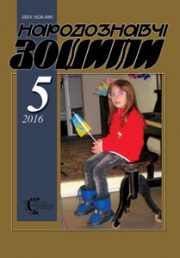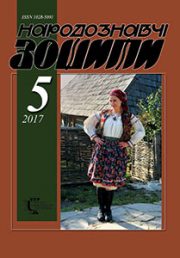The Ethnology Notebooks. 2024. № 1 (175), 170—179
UDK 930.85(=162.1):655.3.006.32(477.43-21)”190/191″
DOI https://doi.org/10.15407/nz2024.01.170
PAUR Iryna
- ORCID: https://orcid.org/0000-0002-5998-8274
- Candidate of Historical Sciences, Associate Professor,
- Kamianets-Podilskiy National Ivan Ohiienko University,
- The Department of Fine and Decorative Art and Restoration,
- 61, Ohiienko st., 32300, Kamianets-Podilskyi, Ukraine,
- Contacts: e-mail: iryna.paur@kpnu.edu.ua
Abstract. The study, using the information potential of postcards, analyses the influence of the Polish intelligentsia on the cultural life of Podillia in the early twentieth century. It is found that despite the active discriminatory policy of the tsarist authorities towards national minorities, the center of the cultural and artistic movement was the provincial center, where the Polish intelligentsia found ways not only to meet their own spiritual and cultural needs but also had a significant impact on the cultural and artistic processes taking place in this territory.
The purpose of the proposed study is to analyze the cultural and artistic practices of individual representatives of the Polish community: photographers and publishers — M. Greim, L. Rakowski, W. Wynarski, poetess J. Gorska, and artist M. Trzebinski, who used postcards to promote their work among the educated population of the region. The paper focuses on the cooperation of Polish and Ukrainian intellectuals in the activities of the Podillia Prosvita Society and their commemoration of the anniversary of T. Shevchenko.
The research methodology is based on the following methods: analytical and synthetic, historical and cultural attribution, figurative and stylistic, iconographic, and comparative analysis.
Conclusion. In Podillia, each of the ethnic groups built its traditional cultural communication. As a result of the uprisings of 1830—1831 and 1861, the Polish population of the region turned from a dominant nation into a politically and socially oppressed ethnic group, but the solvency and education of most of them encouraged local postcard publishers to target their printed products at them. Postcards as a socio-cultural phenomenon of the early twentieth century and an iconographic source made it possible to study the characteristic visual features of the Polish gentry as an ethnographic type; poetic (J. Gorska) and artistic (J. Greim, M. Trzebinski) works of the Polish elite; publishing activities of representatives of the Polish community of Kamianets-Podilskyi — M. Greim, L. Rakowski, and W. Vinarski; cooperation of Polish and Ukrainian intellectuals in raising the cultural and educational level of Podillia residents; ideological beliefs of representatives of the petty and middle gentry of Podillia, represented by J. Gurska, which gives grounds to further use the information potential of postcards to analyze cultural and artistic practices of the region and Ukraine as a whole.
Keywords: Podillia, Polish community, intelligentsia, postcard, culture, art, poetry, pictorial source, «Prosvita».
Received 22.01.2024
REFERENCES
- Bazhenova, S. (2015). The city of Kamianets-Podilskyi was a centre of Polish culture in the second half of the nineteenth century. Osvita, nauka i kul’tura na Podilli, 22, 59—67 [in Ukrainian].
- Pavlovs’kyj, A.S., Shvets’, I.V., & Karpova, T.M. (Ed.). (2023). Leon Rakovsky is a public figure, photographer and poet. Naukovi pratsi Kam’ianets’-Podil’s’koho derzhavnoho istorychnoho muzeiu-zapovidnyka: zb. nauk. prats’ (Vol. 4, pp. 121—127). Kam’ianets’-Podil’s’kyj: FOP Pan’kova L.S. [in Ukrainian].
- Hryhorenko, O. (2009). Poles in Podillia and South-Eastern Volhynia in the early twentieth century (1900—1914). Naukovi zapysky: zb. prats’ molodykh vchenykh ta aspirantiv, 17, 321—328 [in Ukrainian].
- Ursu, N. & Hutsul, I. (2021). Kamyanets in Podilya: the cultural and artistic life of the late XIX — mid XX century. Humanities science current issues: Interuniversity collection of Drohobych Ivan Franko State Pedagogical University Young Scientists Research Papers, 36 (Vol. 3, pp. 47—54). DOI: https://doi.org/10.24919/2308-4863/36-3-8 [in Ukrainian].
- Pidhurnyj, I.S. & Ursu, N.O. (2012). The Cultural and Artistic Heritage of Podillia in the Artistic Photographs of Mykhailo Graim (second half of the nineteenth — early twentieth centuries): monograph. Kam’ianets’-Podil’s’kyj: Aksioma [in Ukrainian].
- Paur, I., & Fentsur, V.V. (Ed.). (2019). Photographs of Kamianets-Podilskyi on postcards by M. Graham. Podillia i podoliany v ob’iektyvi Mikhala Hrejma: materialy kruhloho stolu (Pp. 48—62). Kam’ianets’-Podil’s’kyj: Natsional’nyj istoryko-arkhitekturnyj zapovidnyk «Kam’ianets’»; Drukarnia «Ruta» [in Ukrainian].
- Osetrova, H. (1999). Leon Rakovsky (1856—1908). Poliaky na Khmel’nychchyni: pohliad kriz’ viky: zb.nauk. prats’ za mater. mizhnar. konferentsii (23—24 chervnia 1999 r.) (Pp. 522—524). Khmel’nyts’kyj: Podillia [in Ukrainian].
- Babiuk, D.S., & Kopylov, S.A. (Ed.). (2018). Leon Rakowski in the cultural and public life of Kamianets-Podilskyi in the late nineteenth and early twentieth centuries. Ivan Ohiienko i suchasna nauka ta osvita: nauk. zb.: seriia istorychna (Vol. XIV, pp. 229—237). Kam’ianets’-Podil’s’kyj: Kam’ianets’-Podil’s’kyj natsional’nyj universytet imeni Ivana Ohiienka [in Ukrainian].
- Kopylov, S. & Paur, I. (2019). Kamianets-Podilskyi on postcards of the late nineteenth and early twentieth centuries: a historical and iconographic study. Monograph. Kam’ianets’-Podil’s’kyj: Aksioma [in Ukrainian].
- (1911). From a mournful page. Member-correspondent of the Polish Country-Lovers’ Society Michal Greim. Reprint from the 5th yearbook of the Polish Landscape Society for the year 1911. Retrieved from: https://polona.pl/item-view/df2d407e-eb9f-4182-9e18-586746926936?page=11 (Last accessed: 02.01.2024) [in Polish].
- Paur, I. (2021). Types of defense architecture of Podillia on postcards of the polish society of local lore (1907—1913). Ukrainian culture: the past, modern ways of development: Scientific journals (Vol. 39, pp. 16—23). Rivne: RDHU. DOI: https://doi.org/10.35619/ucpmk.v39i.490 [in Ukrainian].
- Gorski, W. (Pobog). (1902). Mogilev district in the Podolia Governorate: a geographical and historical description of all towns, cities, villages, hamlets, furors, in a word, populated localities in this district, with the addition of relevant documents. Krakow: Drukarnia «Czas» [in Polish].
- Napoleon, Orda. Sledzie. Palac Gorckich. Retrieved from: https://vlasno.info/spetsproekti/1/istoriya/item/13568 (Last accessed: 03.01.2024) [in Polish].
- Kym buv Blazhennyj Yan Bejzym — iezuits’kyj misioner iz Shepetivs’koho rajonu? Retrieved from: https://khmel-pivnich.info/kym-buv-blazhennyy-yan-beyzym-iezuitskyy-misioner-iz-shepetivskoho-rayonu/ (Last accessed: 20.11.2023) [in Ukrainian].
- Gorska, Janina, & Jankowski, E. (Ed.). (1996). Dictionary of Polish Writers’ Pseudonyms XV — 1970 r. (Vol. IV, p. 199). Wroclaw [in Polish].
- (1895). Zaglowka, wl. Krokowskich. Geographical dictionary of the Kingdom of Poland (Vol. XIV, p. 728). Warszawa [in Polish].
- Castles and temples of Ukraine. Retrieved from: https://castles.com.ua/kurivka.html (Last accessed: 14.11.2023) [in Ukrainian].
- Gorska, J. (1907). Poezye i dramata. Serya 3. Warszawa: Wyd-wo ksiegarni nakladowej Jana Kotschedoffa [in Polish].
- (1889). Sledzie. Geographical dictionary of the Kingdom of Poland and other Slavic countries (Vol. X). Retrieved from: http://dir.icm.edu.pl/pl/Slownik_geograficzny/Tom_X/757 (Last accessed: 05.10.2023) [in Polish].
- Czartoryski-Sziler, P. (2015). Court libraries. GUTW e-Gazette, 1. Retrieved from: http://gutw.pl/e-gazetka/biblioteki-dworskie.php (Last accessed: 22.11.2023) [in Polish].
- Gorska, J. (1903). Poezye. Serya 2. Warszawa: Teodor Paprocki i S-ka [in Polish].
- K. Namyslowski Philharmonic Orchestra. Retrieved from: https://www.zamosciopedia.pl/index.php/ow-oz/item/4227-orkiestra-wloscianska-im-k-namyslowskiego (Last accessed: 08.12.2023) [in Polish].
- Nawrocka, E. (2021). Karol Namyslowski and his activities. Zamojski Archivarius (Vol. XIX, pp. 269—278) [in Polish].
- Zhad’ko, V. (2012). Kyiv photographer Taras Shevchenko. Kryms’ka svitlytsia, 6. Retrieved from: http://svitlytsia.crimea.ua/?section=article&artID=9928 (Last accessed: 19.12.2023) [in Ukrainian].
- Zabochen’, M., Polischuk, O. & Yatsiuk, V. (2000). Ukraine in an old postcard: a catalogue album. Kyiv: Krynytsia [in Ukrainian].
- Scherban’, A. (2020). Discovering Mykhailo Dyachenko. Retrieved from: https://podolyanin.com.ua/history/48886/ (Last accessed: 20.12.2023) [in Ukrainian].
- Pryschepa, O. (2015). The exhibition and educational activities of the artist V.K. Rozvadovskyi as a factor in the formation of the urban cultural environment of the Right-Bank Ukraine in the early twentieth century. Intelihentsiia i vlada (Vol. 33, pp. 220—237) [in Ukrainian].
- Trubchaninov, S.V. (2011). Territorial and urban heraldry of Podillia: history and current state. Osvita, nauka i kul’tura na Podilli (Vol. 18, pp. 424—440) [in Ukrainian].






